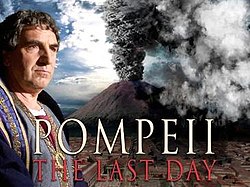This article needs additional citations for verification .(April 2010) |
| Pompeii: The Last Day | |
|---|---|
 Title screenshot | |
| Genre | Docudrama |
| Written by | Edward Canfor-Dumas |
| Directed by | Peter Nicholson |
| Starring | |
| Narrated by | |
| Composer | Ty Unwin |
| Country of origin | United Kingdom |
| Original language | English |
| Production | |
| Executive producer | Michael Mosley |
| Producer | Ailsa Orr |
| Running time | 90 minutes |
| Original release | |
| Network | BBC One |
| Release | 20 October 2003 |
| Related | |
Pompeii: The Last Day is a 2003 dramatized documentary that tells of the eruption of Mount Vesuvius towards the end of August 79 CE. [1] [2] This eruption covered the ancient Roman cities of Pompeii and Herculaneum in ash and pumice, killing a large number of people trapped between the volcano and the sea. The documentary, which portrays the different phases of the eruption, was directed by Peter Nicholson and written by Edward Canfor-Dumas.